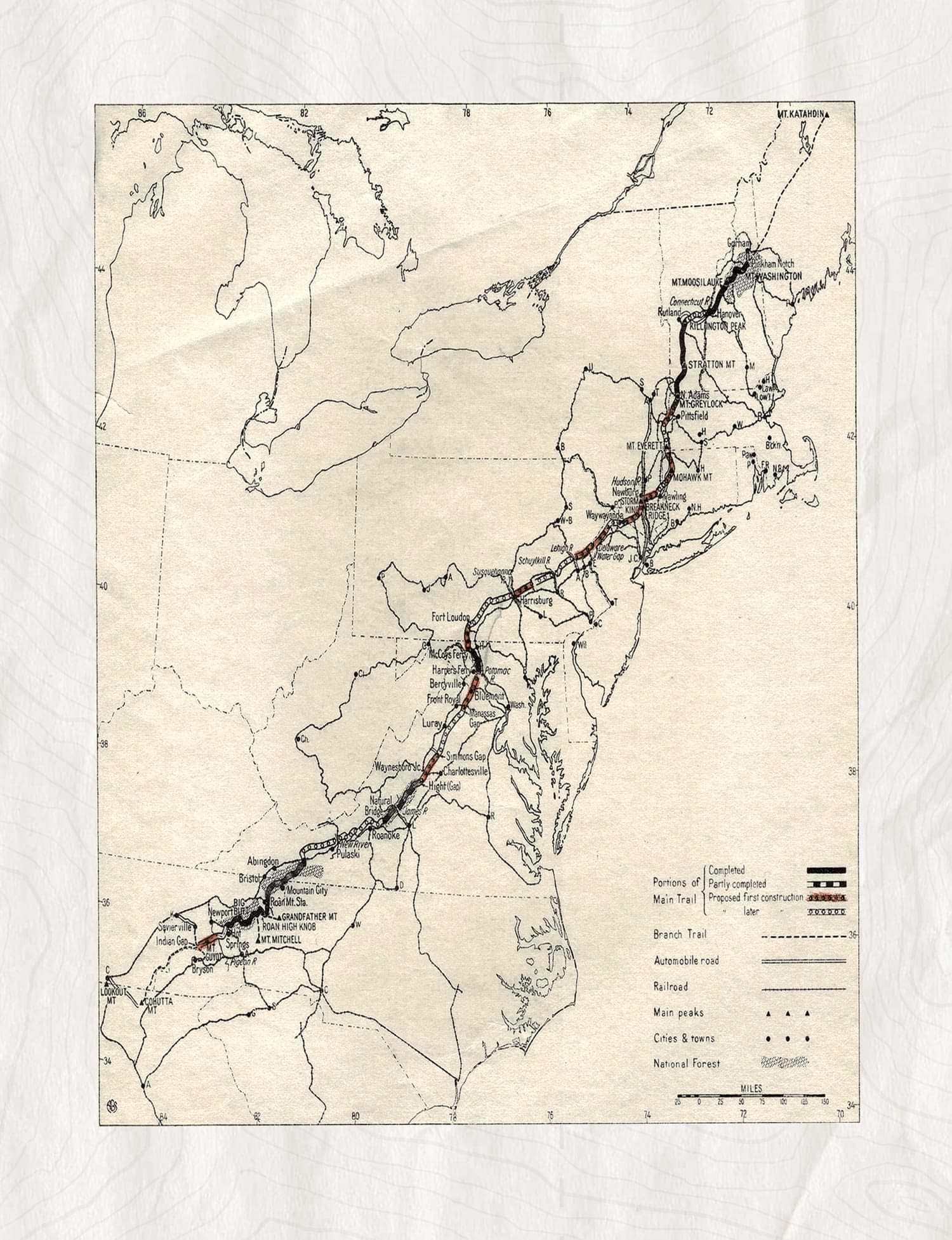A realm and not a trail marks the full aim of our effort. The trail is but the entrance to the final thing we seek — the thing eternal which we have called primeval influence — that opposite thing from “metropolitan” influence (the present passing phase of a hectic civilization).
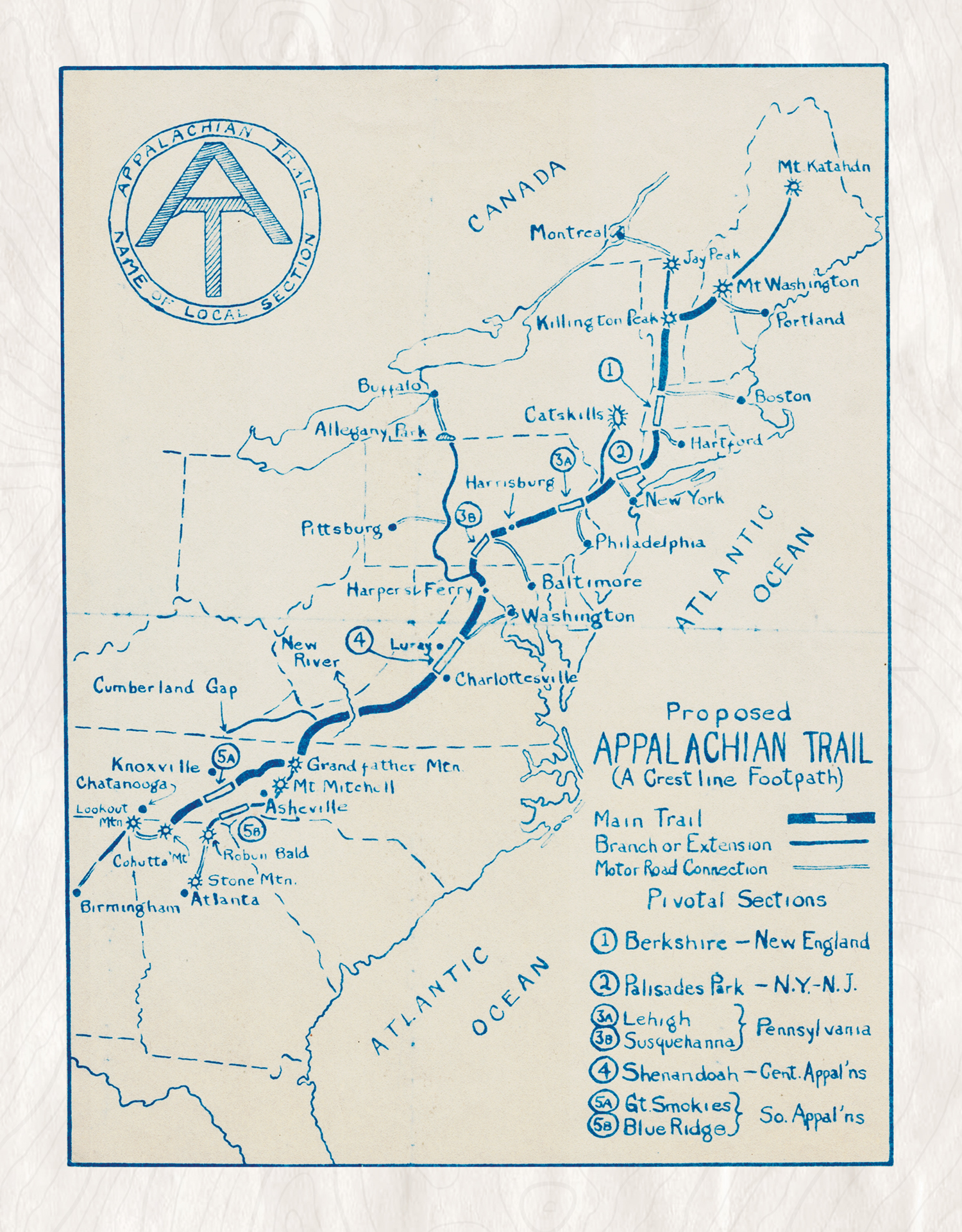
A realm and not a trail marks the full aim of our effort. The trail is but the entrance to the final thing we seek — the thing eternal which we have called primeval influence — that opposite thing from “metropolitan” influence (the present passing phase of a hectic civilization).
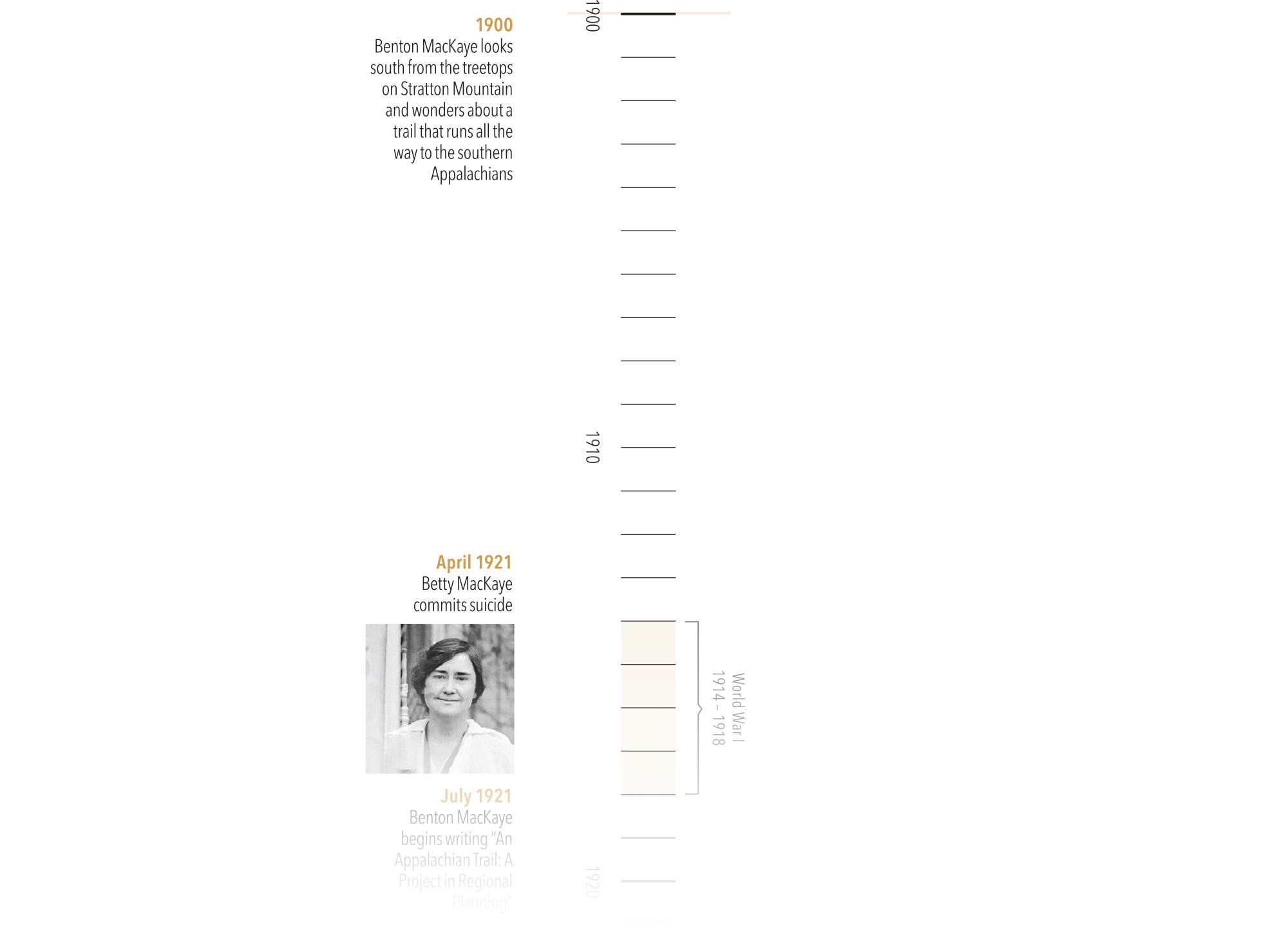
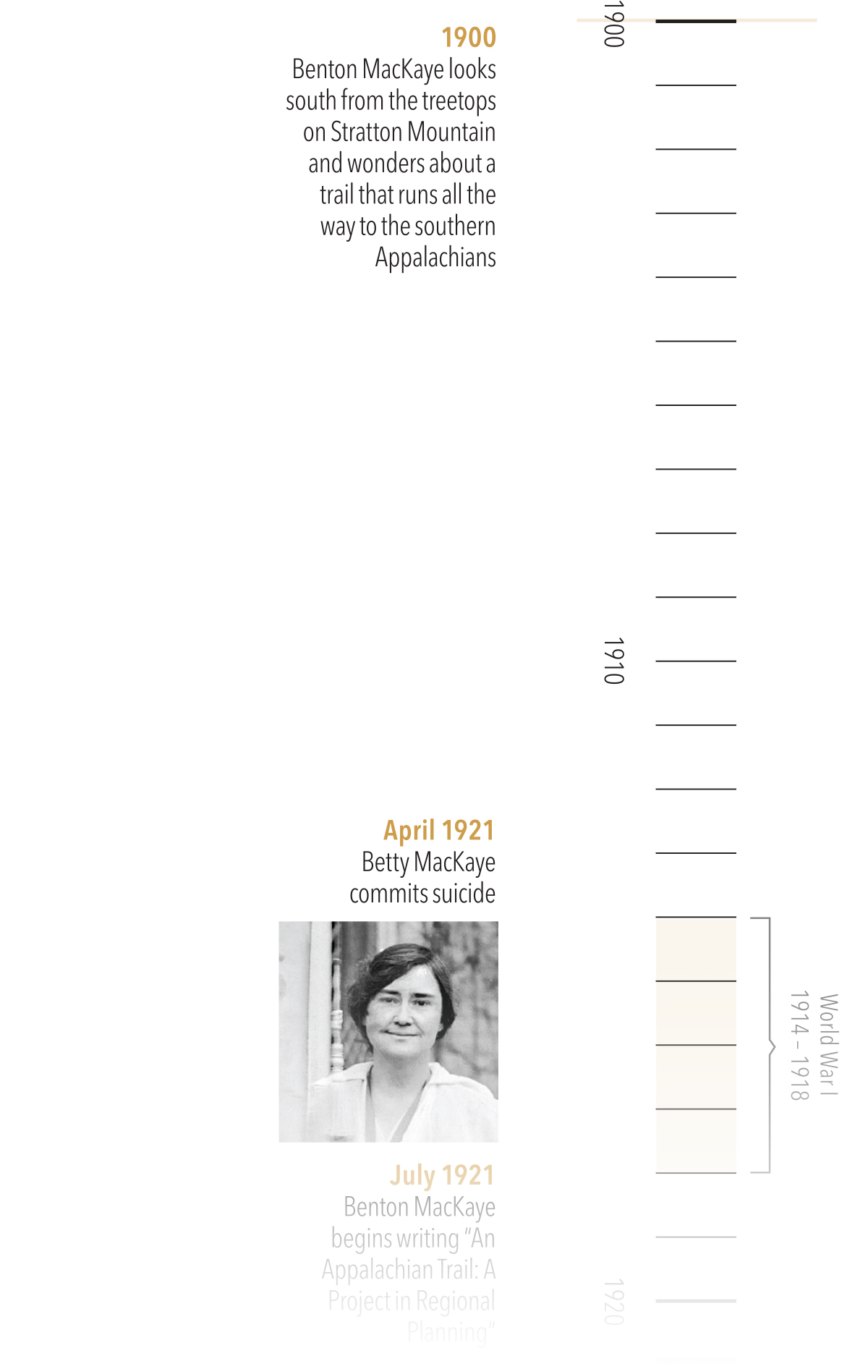

Sandra Marra / President & CEO
Nicole Prorock / Chief Financial Officer
Shalin Desai / Vice President of Advancement
Laura Belleville / Vice President of Conservation & Trail Programs
Cherie A. Nikosey / Vice President of Administration
Brian B. King / Publisher
Wendy K. Probst / Editor in Chief
Traci Anfuso-Young / Art Director / Designer
Alyssa Reck / Social Media Manager
Brittany Jennings / Proofreader
The Appalachian Trail Conservancy’s mission is to protect, manage, and advocate for the Appalachian National Scenic Trail.
Colin Beasley / Chair
Robert E. Hutchinson, Jr. / Vice Chair
James LaTorre / Secretary
Patricia Shannon / Treasurer
Daniel A. Howe / Chair, Stewardship Council
Sandra Marra / President & CEO
Grant L. Davies
Norman P. Findley III
Thomas Gregg
John W. Knapp, Jr.
Ann Heilman Murphy
Colleen Peterson
Eboni Preston
Nathan G. Rogers
Rubén A. Rosales
Rajinder Singh
Nicole Wooten
Hon. Stephanie Martz / Chair
Diana Christopulos
Jim Fetig
Lisa Koteen Gerchick
Mark Kent
R. Michael Leonard
Robert Rich
The Hon. C. Stewart Verdery, Jr.
A.T. Journeys is published on Somerset matte paper manufactured by Sappi North America mills and distributors that follow responsible forestry practices. It is printed with Soy Seal certified ink in the U.S.A. by Sheridan NH in Hanover, New Hampshire.
A.T. Journeys ( ISSN 1556-2751) is published by the Appalachian Trail Conservancy, 799 Washington Street, Harpers Ferry, WV 25425, (304) 535-6331. Bulk-rate postage paid at Harpers Ferry, West Virginia, and other offices. Postmaster: Send change-of-address Form 3575 to A.T. Journeys, P.O. Box 807, Harpers Ferry, WV 25425.
The Appalachian Trail Conservancy’s mission is to protect, manage, and advocate for the Appalachian National Scenic Trail.
Colin Beasley / Chair
Robert E. Hutchinson, Jr. / Vice Chair
James LaTorre / Secretary
Patricia Shannon / Treasurer
Daniel A. Howe / Chair, Stewardship Council
Sandra Marra / President & CEO
Grant L. Davies
Norman P. Findley III
Thomas Gregg
John W. Knapp, Jr.
Ann Heilman Murphy
Colleen Peterson
Eboni Preston
Nathan G. Rogers
Rubén A. Rosales
Rajinder Singh
Nicole Wooten
Hon. Stephanie Martz / Chair
Diana Christopulos
Jim Fetig
Lisa Koteen Gerchick
Mark Kent
R. Michael Leonard
Robert Rich
The Hon. C. Stewart Verdery, Jr.
The Appalachian Trail Conservancy’s (ATC) President and CEO, Sandra “Sandi” Marra has spent most of her adult life volunteering and working on behalf of the Appalachian Trail and the ATC. She has been an A.T. volunteer for more than 35 years, is a former member and Chair of the ATC Board and former President of the Potomac Appalachian Trail Club (PATC). She and her husband oversee three miles of the A.T. in northern Virginia and are co-managers of PATC’s Blackburn Trail Center.
As she now leads the ATC in celebration of this hundred years past, she also is excited for the organization’s future. “We are poised to build on this incredible foundation to create an even stronger and more resilient organization that can ensure the future protection of the Trail and all that surrounds it. It is time to fully realize MacKaye’s vision for the landscape of the Appalachian Trail,” she says.
The Appalachian Trail Conservancy’s (ATC) Vice President of Advancement, Shalin Desai, found himself transformed after his 2015 thru-hike of the Appalachian Trail. The experience is best summarized by a quote from Robert Moor’s book, On Trails: “On wild land, wild thoughts can flourish. There, we can feel all the ragged edges of what we do not know, and we make room for other living things to live differently.” For him, and doubtless for many others, this quote captures why the Trail, its landscape, its community, and its experiences are worth protecting for another century.
After completing the Triple Crown of long-distance hiking in 2017, Shalin joined the ATC’s staff in 2019 and now leads the Conservancy’s membership, development, communications, education and outreach, and visitor services teams. Previously, he served on the ATC’s Board of Directors.
Brian B. King is the Publisher of books and maps for the Appalachian Trail Conservancy (ATC), with which he has been involved since 1979, joining the staff as Director of Public Affairs in 1987. Until their transfer to George Mason University, he also was gatekeeper of the ATC’s archives. Previously, he was a news reporter and editor for fourteen years, interrupted by two years in the Army; served as editor for a special project for the U.S. secretary of agriculture for a year; and worked for a Washington, D.C., agricultural-policy nonprofit for six years. “Each year, not unlike the ATC and the Trail itself, the stories of the footpath and the major figures associated with it have emerged from early cocoons of mythology into more solid histories and perspectives. This commemorative edition is a modest, further step forward in that direction,” he says.
Jordan Bowman is the Director of Communications for the Appalachian Trail Conservancy (ATC). After spending many of his formative years hiking the Appalachian Trail in Georgia and the Southeast, Jordan fulfilled his dream of thru-hiking the Trail in 2014. That experience led him to his role at the ATC, helping both newcomers and experienced hikers discover new ways to enjoy, protect, and celebrate this one-of-a-kind Trail. “Even 100 years after Benton MacKaye first laid out his vision for the Appalachian Trail, we continue to find new ways that it benefits us and the world around us,” he says. “By examining MacKaye’s words through the context of a century of on-the-ground conservation work, we can see what has been accomplished — and what is still needed — to conserve and protect the A.T. forever, for all.”
As the Editor in Chief of A.T. Journeys, Wendy Probst is thrilled to combine her devotion to conservation work with her lifelong love of shaping and sharing words and stories. Growing up in Maryland, Wendy warmly remembers autumn family picnics at Washington Monument State Park — but had no idea at the time how much the Appalachian Trail would one day be such a huge part of her life and professional career.
She has spent the past sixteen years with the Appalachian Trail Conservancy (ATC) interlacing and presenting the extraordinary efforts and narratives behind the Trail and the ATC’s work. And putting that English degree to good use. “This one-of-a-kind issue of the magazine is akin to an epic adventure in time travel. Working with a phenomenal team to create it has been the pinnacle and education of my editorial career,” she says. “And it sets the stage for a bright and winding path that I can’t wait to follow into the future with the ATC.”
Traci Anfuso-Young is a freelance graphic designer and adjunct professor who brings 32 years of experience in publishing to the Appalachian Trail Conservancy (ATC). She began her design career with Rodale Press in 1989 at Backpacker magazine and later became Art Director of Mountain Bike magazine. In 2002, she launched her own business, TLA Design Studio, and became A.T. Journeys Graphic Designer in 2010.
Through her decade of work with A.T. Journeys, she says, “I’ve been able to live my passion as a designer, while experiencing the thrill of adventure and the rewards of others who’ve traversed this Trail. This 2021 milestone and the content of this issue are ones of thoughtful opportunity. As I reflect, I’ve come to realize that we stand at the precipice of something grand. Through my work with the ATC, I feel connected to the optimism and healing that the Trail and nature provide.”
By Sandra Marra
12 / An Appalachian Trail: A Project in Regional Planning /
By Benton MacKaye
20 / Trails Connect /
By Shalin Desai
22 / The A.T. in its second century /
By Daniel Anthony Howe
34 / What were you thinking, benton?
Decoding MacKaye /
By Brian B. King
37 / Uncle Benton /
By Ky Ober
42 / From Trauma to Dream
MacKaye’s Troubled Path to the Appalachian Trail /
By Larry Anderson
50 / from benton to myron: the dreamer, the driver /
By David B. Field
56 / Standing on the Shoulders of Giants
The Emerging Realization of MacKaye’s Vision /
By James N. Levitt
68 / Resilient by Nature
The A.T. landscape is home to abundant natural resources worth protecting /
By Kim O’Connell
76 / a Planetary feeling /
By Tony Hiss
86 / The people of the people’s trail /
By Derrick Z. Jackson
92 / Parting Thought: Getting to Work /
By Laura Belleville
Photo by Koty Sapp
This is in no way to detract from what has been accomplished in the last hundred years: A continuous footpath of 2,193 miles flanked by a protective corridor of more than 250,000 acres, home to thousands of plant and animal species, including 2,000 classified as rare, threatened, endangered, and/or sensitive. To the millions who step foot on the treadway each year, the Appalachian Trail represents both physical challenge and spiritual renewal. For the thousands who volunteer to manage and maintain it, the Trail is an accomplishment, a personal legacy, and a place to blend stewardship with camaraderie. In 100 years, we have created an iconic place, steeped in ideals and mythology but grounded in sweat and perseverance.
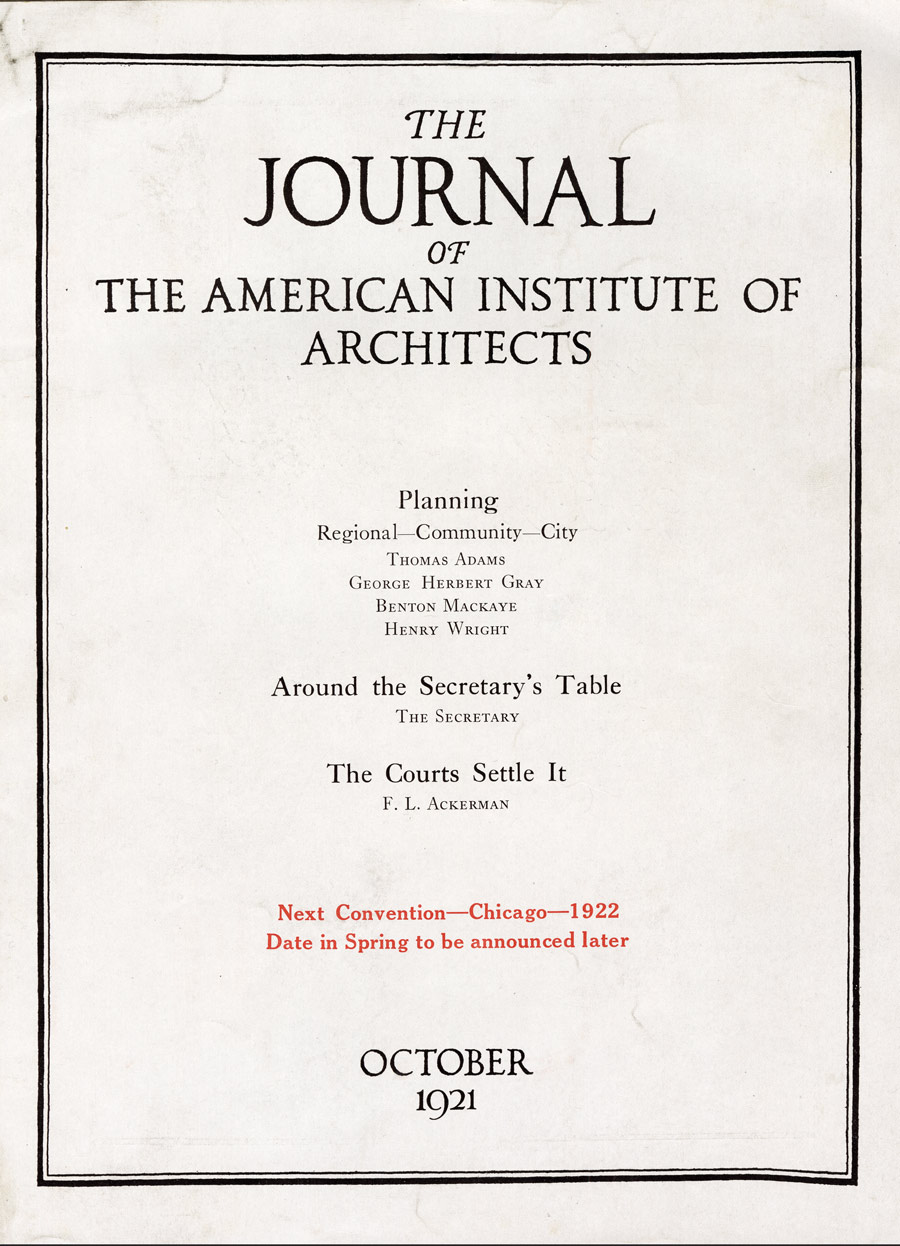
Building, maintaining, and protecting trails is, at its core, meant to nurture connection.
But, in this connection there is also diversity. The diversity of experiences to be found on and off the trail. The diversity of ways people find connection to the trail and its resources, through recreation, stewardship, advocacy, and other forms of enjoyment and support. There is also diversity in the array of benefits trails can provide. And, of course, there is diversity of perspectives and identities found among the broader trail community.
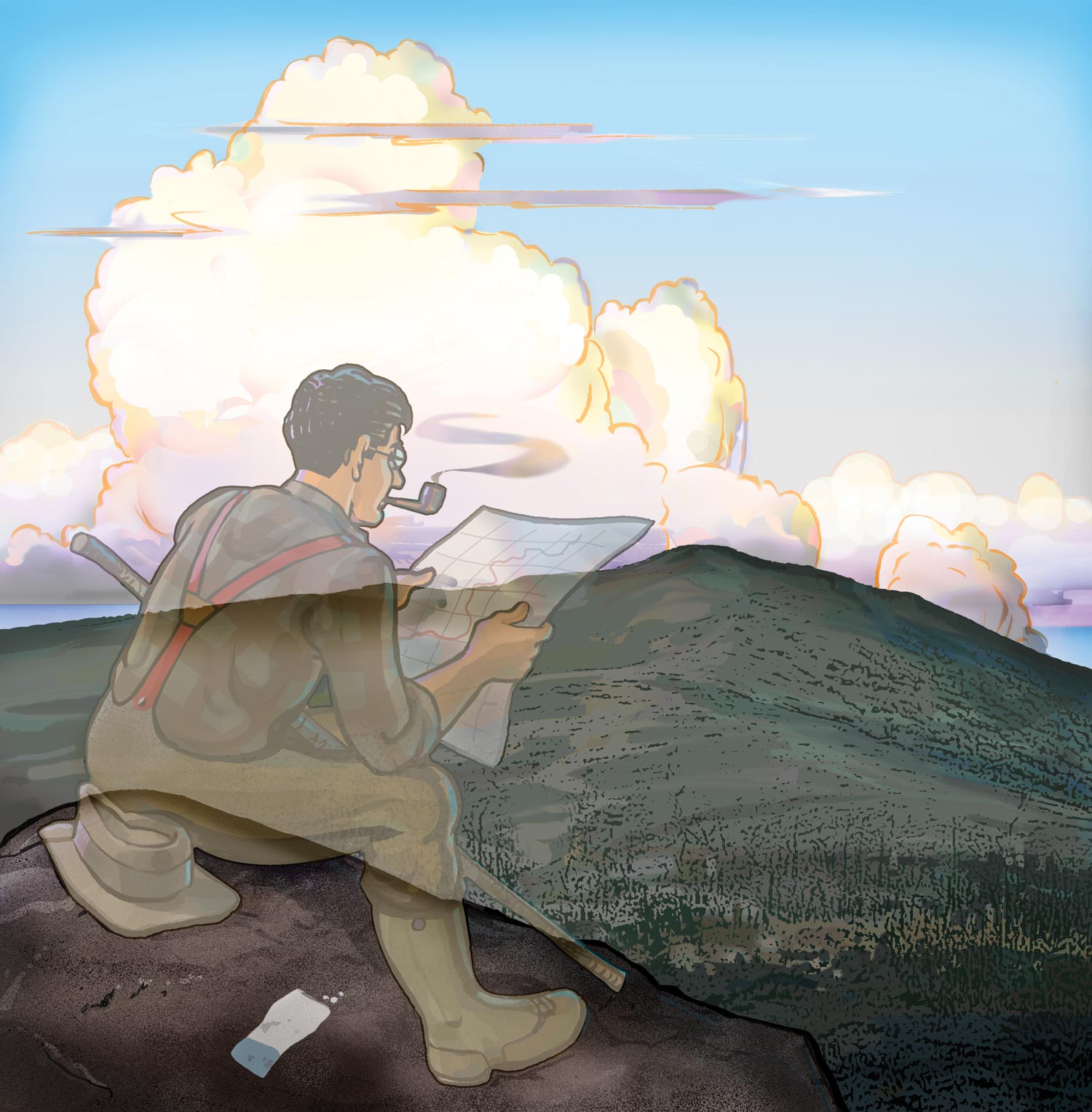
hat does the Appalachian Trail mean to the East, to the country, and to the world in the next century of its existence? The experience of the first 100 years sets us up to move toward a new vision — a truly regional ethic of conservation, economic health, stewardship of the natural world, and fellowship among the broad and diverse array of humanity surrounding the Appalachian Mountains.
Benton MacKaye’s 1921 vision was a public declaration of a grand idea, an important leap of faith at that moment in history, and, most importantly, a call to action. The country was emerging from many challenges, including its involvement for the first time in a major foreign war, as well as rapid urbanization and expansion of the nation’s cities in the wake of the Industrial Revolution. And, much as it is today, society was challenged by income inequality, a global pandemic in 1918, racial conflict, and a large influx of immigrants altering the ethnic and cultural landscape of the country. At the same time, the population in rural America was in decline as more sought work in cities, a trend that continues today. MacKaye, a keen student of the social impact of urbanization, looked ahead to a time when the expansion and encroachment of the built environment upon the existing natural landscape would push us all further and further from a life-sustaining connection to nature, and, in doing so, threaten the very existence of the forests and fields that so defined the wild lands in the East he experienced as a child.
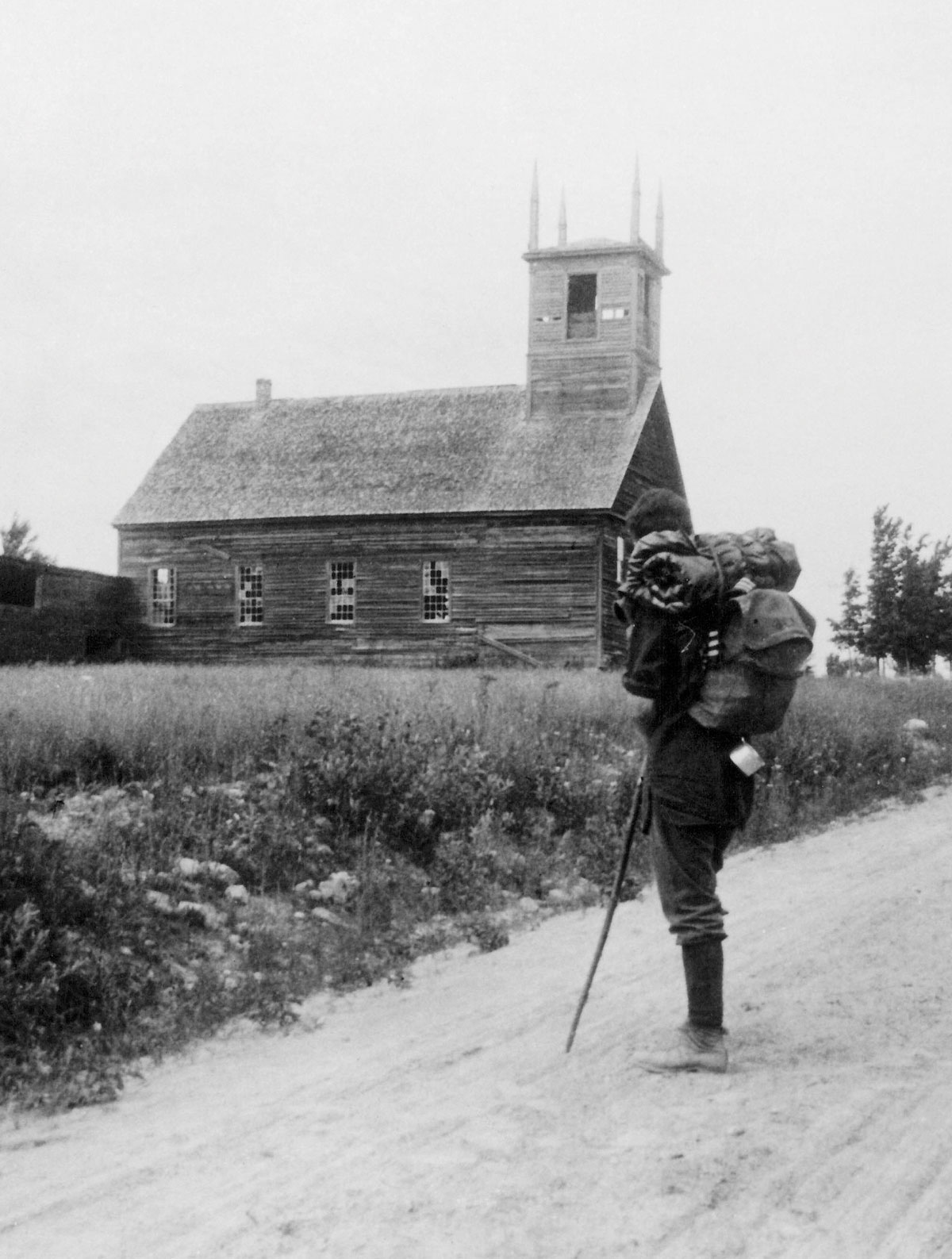
Photo courtesy of Dartmouth College Library
rmchair trail advocate. Avant-garde conservationist. Conservation’s inseminator. Craggy New Englander. Cultural democrat. Eccentric. Ecologist. Failure. Head in the clouds. Humanist. Incidental naturalist. Incorrigible optimist. Journalist. Mayflower descendant. Naturalist. Nestor of the Appalachian Trail. Nineteenth-Century Romantic. Political radical. Prophet. Regional planner. Sage of Shirley Center. Single-taxer. Socialist. Unemployed. Utopian Socialist. Visionary. Wilderness advocate. Woodsman. “Forester, philosopher, and dreamer.”
That last description of Benton MacKaye came from Myron H. Avery and became the accepted “definition” in Appalachian Trail folklore and history for the next half-century or more, writings that set Avery apart as the “doer.”
Most of those descriptions are true but individually incomplete. Some are unfair, even false. Scores of doctoral dissertations containing such descriptions — and a number of books drawn from them — have attempted to define or pigeonhole MacKaye. Most of those papers have never made it into the Appalachian Trail Conservancy archives, much less into the long-held internal portraits of the progenitor of the A.T.
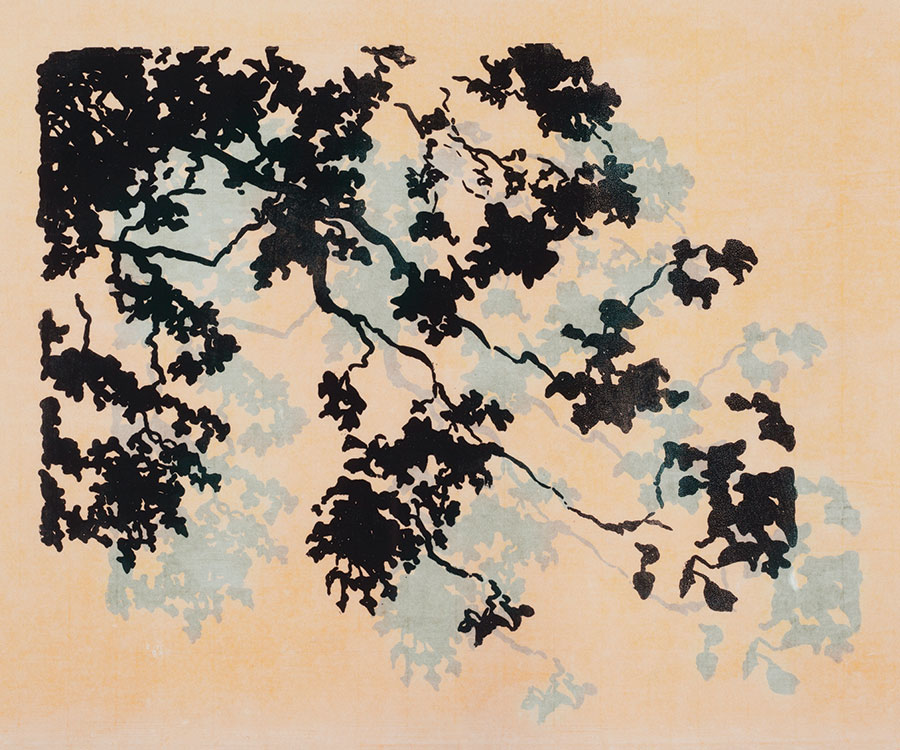
MY GREAT-UNCLE BENTON SPENT EVERY summer with us at our home in New Hampshire. When my grandfather was alive, the two brothers spent hours walking and talking together, then each retiring to his work — my grandfather to his poetry, Uncle Benton to his philosophizing, his numerous letters, and his meticulous daily diary.
Every morning at breakfast, Uncle Benton would tell of his adventures, and we all, loving them, would egg him on: “Sixty years ago today, I embarked on my first grand excursion into the wilderness…,” he would say. The experience and the telling were grand and expansive, but Uncle Benton’s voice was very much of the present, direct, emphatic, feet on the ground, bushwhacking through before you could reach the awe-inspiring view from the top.
Uncle Benton was staunchly loyal to family and close friends, and his friends to him. Lewis Mumford, Clarence Stein, and many others stayed in touch regularly, and Benton would catch us up on their lives, so we had as examples for our own lives, the richness of enduring friendship. And to all those who were lucky enough to be in Uncle Benton’s circle of warm and embraced “family,” he signed off with his distinctive “Arms Out, Benton.”
Chine-colle’, monoprint lithograph on Japanese paper “I hope the print captures that moment at the end of a summer day when the light is still there, but warm, glowing. All is still, warmth, peace.” -Ky Ober
–
Ky (Marion MacKaye) Ober grew up in New York City in the winters and at her grandfather’s (Percy MacKaye’s) Cornish Colony home in New Hampshire in the summers. She was deeply influenced by the rich cultural life of the city and the direct encounter with nature and creative life she experienced there with her grandfather and great-uncle Benton. She attended the Rudolf Steiner School where both her parents taught, and she later received an undergraduate degree in biology and graduate degree in Landscape Architecture, only to study art at the School of the Museum of Fine Arts at Tufts University and teach there as an associate faculty member for many years. Through her position on the Boston Printmakers Board, she has been able to participate in and support student and professional printmakers through national exhibitions and international printmaking exchanges and has enjoyed extensive travel and collaborative work with other artists. She lives with her husband in Arlington, Massachusetts.
–
Chine-colle’, monoprint lithograph on Japanese paper “I hope the print captures that moment at the end of a summer day when the light is still there, but warm, glowing. All is still, warmth, peace.” -Ky Ober
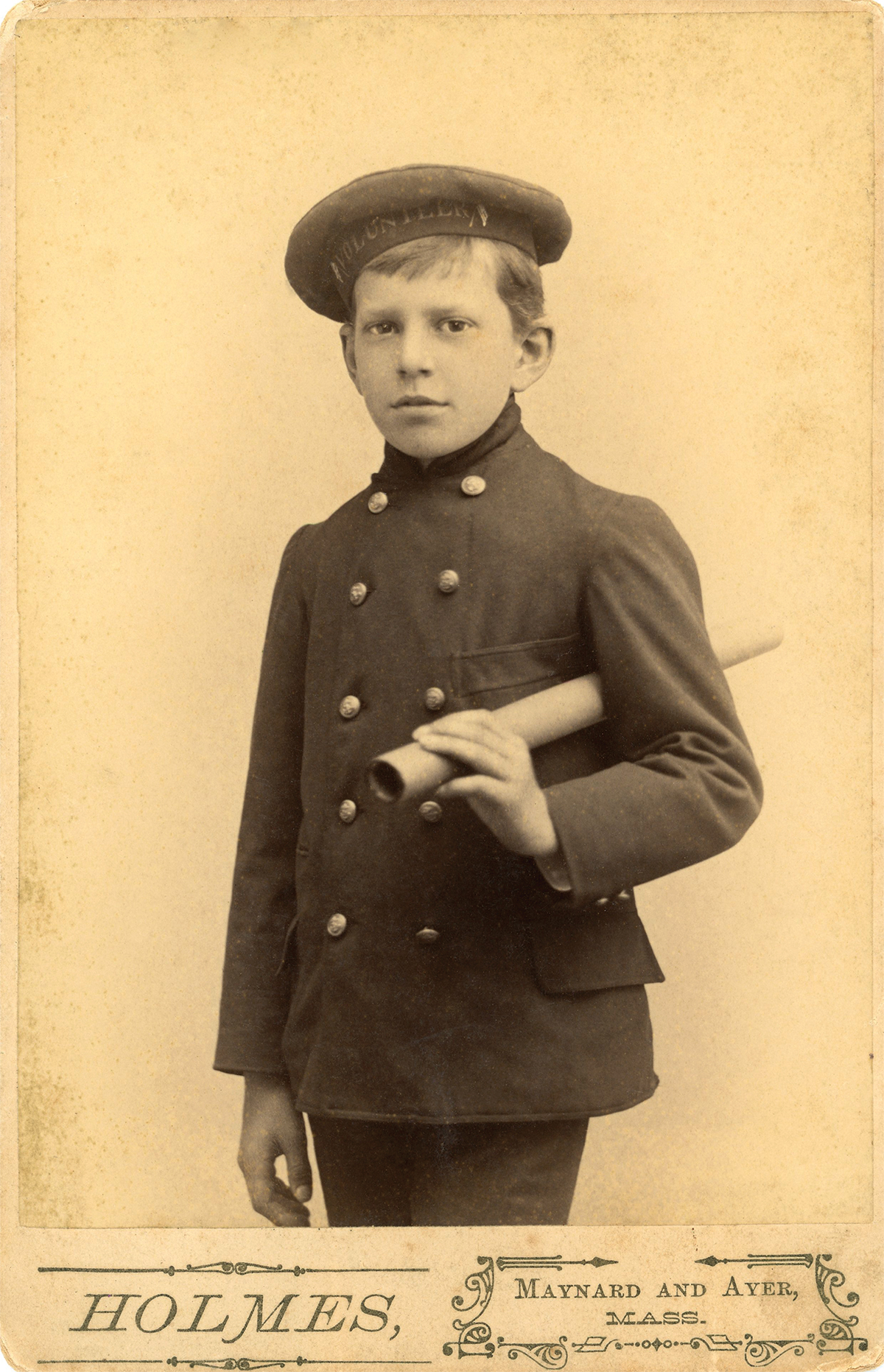
Photo courtesy of the Shirley Historical Society and the A.T. Museum
ashington went down like a tent. Everything dropped. That was the real beginning of normalcy right there.” Benton MacKaye, years later, recalled the mood and the events in the nation’s capital after the November 1918 armistice that ended World War I. By then, Washington, D.C., had been MacKaye’s home and headquarters since 1911, as he worked energetically and productively for two new federal agencies, the U.S. Forest Service and the Department of Labor.
During those postwar years, the course of MacKaye’s life and career veered sharply and erratically. This period, from late 1918 through 1921, proved truly pivotal for his personal life and public legacy.
His personal circumstances mirrored the tumultuous political, economic, and cultural events then roiling the nation: the Spanish influenza pandemic beginning in 1918; bitter struggles between labor and industry; racial riots, some of which led to mass killings, lynchings, and the destruction of Black neighborhoods; a roller-coaster economy, punctuated by periods of high unemployment, inflation, and housing shortages; the climax of the long crusade for women’s suffrage; a 1917 revolution in Russia and the rise of a new communist Soviet regime; and, in response, an American “Red Scare” in 1919-1920.
Photo courtesy of the Shirley Historical Society and the A.T. Museum
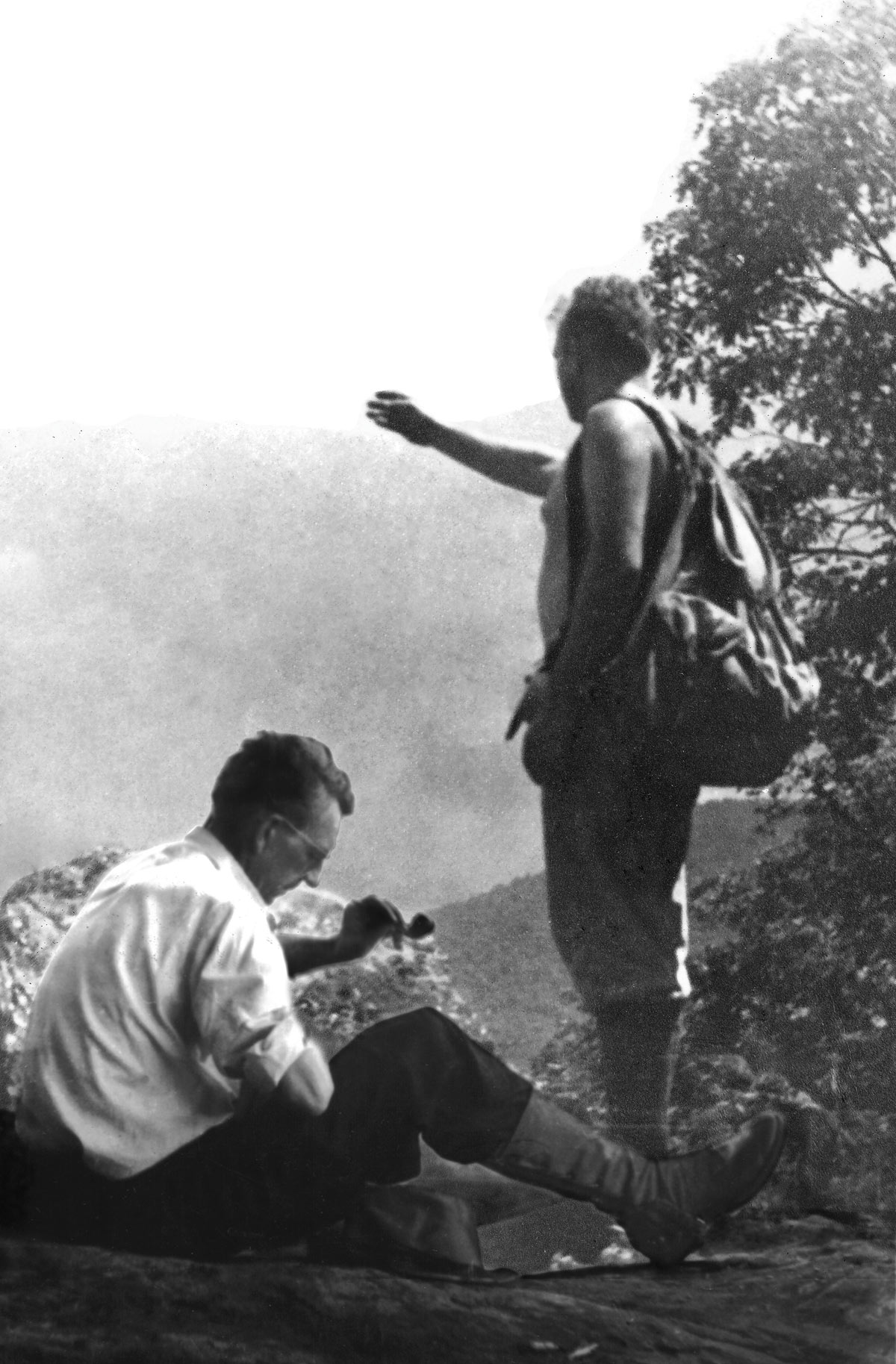
hapter twelve of Benton MacKaye’s 1928 book, The New Exploration, is entitled, “Controlling the Metropolitan Invasion.” He viewed uncontrolled expansion of development from urban centers along motorways — analogous to a flow of water from an improperly controlled reservoir — as a threat to the countryside. He envisioned a series of “open areas” along the Appalachian mountain range as a “dam across the metropolitan flood.” Motorways could still pass through, but the preserved open areas would thwart development along those routes. He felt that the developing Appalachian Trail (A.T. or Trail) “marked the main open way across the metropolitan deluge issuing from the ports of the Atlantic seaboard.” It would “form the base…for controlling the metropolitan invasion.”
Photo by Koty Sapp
isionary leaders have a rare and remarkable talent: the ability to “bring people together around a common goal and provide …a focal point for developing strategies to achieve a better future,” as organizational consultants Ron Ashkenas and Brook Manville put it.
Benton MacKaye, in his October 1921 article imagining the Appalachian Trail, was able to articulate the “simple, bold, inspirational vision” Ashkenas and Manville advocate — a giant, precedent-setting plan that has motivated a strong and enduring community to achieve a common goal for what is now a century.
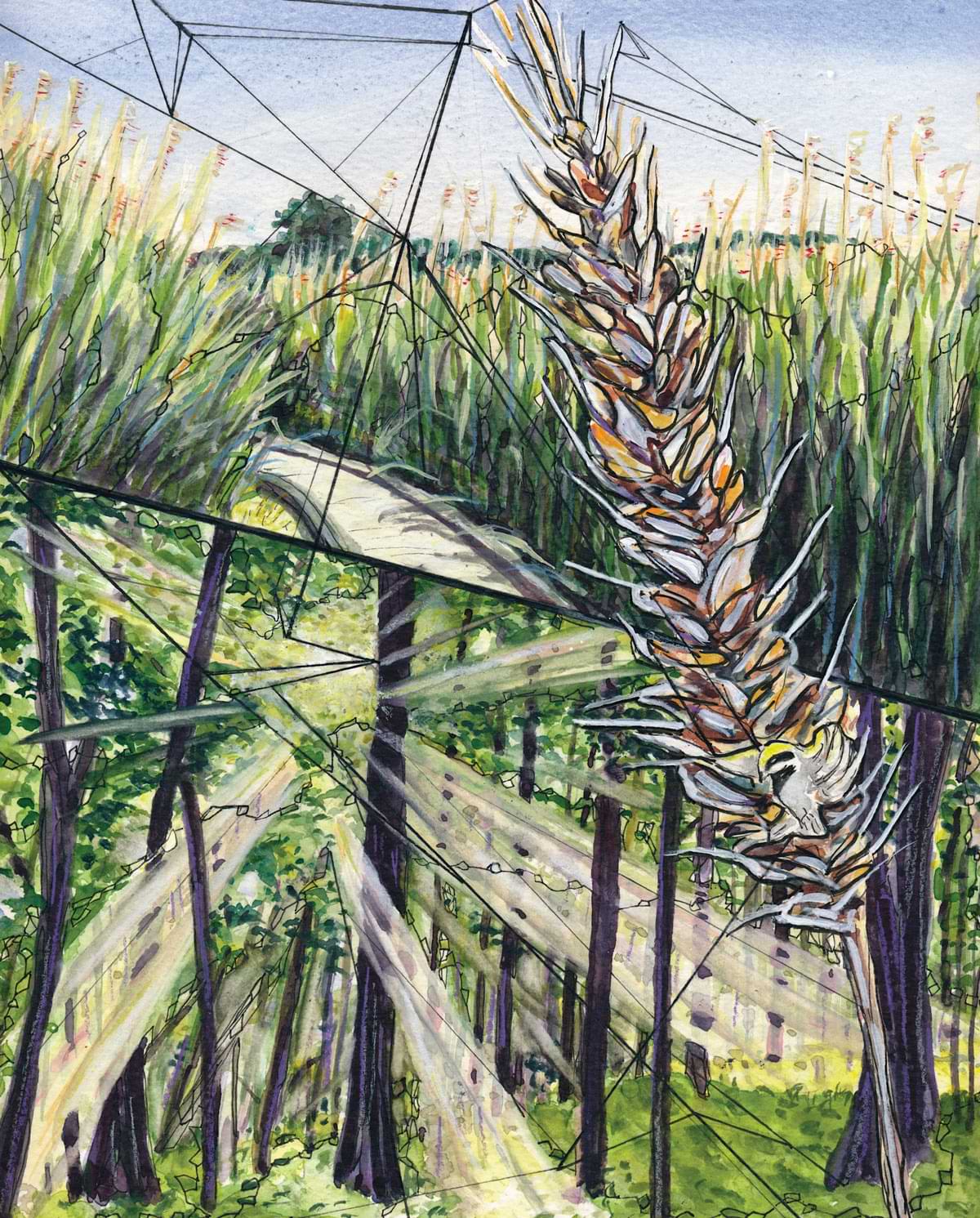
Watercolor, ink, and colored pencil on paper — features two vital landscapes connected by the Appalachian corridor: The magical light sifting through the trees in the southern Appalachian Mountains and a forest of grasses in Connecticut.
t is a burnished-gold morning in late September, and fall has begun to arrive in Shenandoah National Park. Orange and yellow leaves pepper the green foliage, catching the light like sequins. Although it still feels warm in the sun, a light, cool breeze brings the first hint of the autumnal weather to come. The year is rounding a corner, moving into a new season. Soon, thousands of migrating broad-winged hawks and other raptors will be seen overhead as they make their way south for the winter. Tall grasses in the meadows will turn rust-colored, and leaves will fall gently to the earth.
Watercolor, ink, and colored pencil on paper — features two vital landscapes connected by the Appalachian corridor: The magical light sifting through the trees in the southern Appalachian Mountains and a forest of grasses in Connecticut.
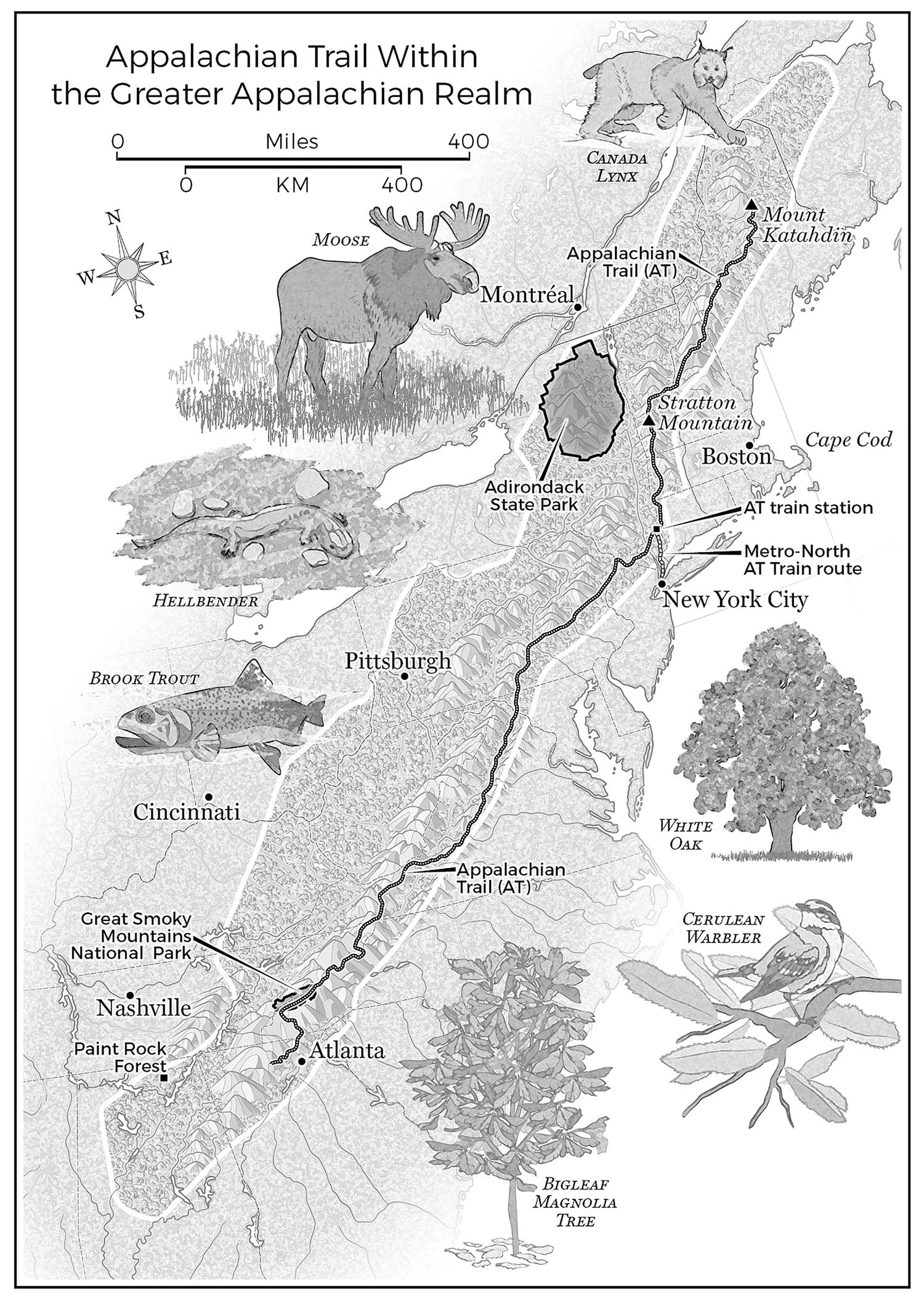


lways in the back of my mind when thinking about protecting 50 percent of Earth’s land by 2050 is Benton MacKaye — someone whose thoughts roamed far and wide as he looked around and who then reshaped the world. He had just graduated from college when, in the summer of 1900, he and a friend bushwhacked their way up Stratton Mountain, the highest peak in southern Vermont. (The story can be found in Larry Anderson’s biography, Benton MacKaye.) There were no trails to follow, and, at the summit, they shinnied up tall, swaying trees to get a better view. For MacKaye, this was an aha! moment whose echoes can still be heard.

AM THE VERY ACCIDENTAL BLACK NATURE LOVER.
I was a typical urban boy in Milwaukee and a rabid sports fan in the 1960s. The most significant eagles to me played football in Philadelphia. The first cardinal I ever paid attention to was Bob Gibson throwing fastballs for St. Louis. My first confirmed sighting of an oriole was Frank Robinson blasting home runs for Baltimore. Bears and lions were fauna native to Chicago and Detroit and invasive species in Green Bay.
A dismal failure at actual sports, I did the next-best thing. I became a sportswriter and photographer. In college, I covered high school sports for the Milwaukee Journal. I shot for the Associated Press at Green Bay Packers games and the 1974 National Basketball Association (NBA) finals between the Milwaukee Bucks and the Boston Celtics. By 1979, at the age of 23, I was covering the New York Knicks and the NBA finals for Newsday.
I don’t think that any of us is born a conservationist, at least not with fully formed ideas about ecosystems or a land ethic. That understanding comes after experiencing the outdoors, making sense of it, and finding the language to describe what we saw. For some, that language sounds like science, and, for others, it’s a painted picture or photograph or a hiker journal. But, it is innately human to go out into nature to discover, to find ourselves and all the world has to offer. And, at times, to hit the reset button. Benton understood this, for sure. He banked on those understandings to protect the Appalachian landscape.
The Appalachian Trail Conservancy
Would Like to Thank
Charlies Bunion, Great Smoky Mountains National Park
Photo by Erin Miller
ATC Board of Directors
Colin P. Beasley / Chair
Robert E. Hutchinson, Jr. / Vice Chair
James LaTorre / Secretary
Patricia Shannon / Treasurer
Daniel A. Howe / Chair, Stewardship Council
Sandra Marra / President & CEO
Grant L. Davies
Norman P. Findley III
Thomas Gregg
John W. Knapp, Jr.
Ann Heilman Murphy
Colleen Peterson
Eboni Preston
Nathan G. Rogers
Rubén A. Rosales
Rajinder Singh
Nicole Wooten
And all those who have served on the ATC Board previously
President’s Leadership Circle
The Hon. Stephanie Martz / Chair
Diana Christopulos
Jim Fetig
Lisa Koteen Gerchick
Mark Kent
R. Michael (Mike) Leonard
Robert Rich
The Hon. C. Stewart Verdery, Jr.
And all those who have served on the President’s Leadership Circle previously
Next Generation Advisory Council
And all those who have served on the Next
Generation Advisory Council previously
Our esteemed partners in the National Park Service
Our esteemed partners in the United States Forest Service
Our esteemed state agency partners
Allentown Hiking Club
AMC – Western Massachusetts Chapter
AMC – Connecticut Chapter
AMC – Delaware Valley Chapter
Appalachian Mountain Club
Batona Hiking Club
Blue Mountain Eagle Climbing Club
Carolina Mountain Club
Cumberland Valley Appalachian Trail Club
Dartmouth Outing Club
Georgia Appalachian Trail Club
Green Mountain Club
Keystone Trails Association
Maine Appalachian Trail Club
Mount Rogers Appalachian Trail Club
Mountain Club of Maryland
Nantahala Hiking Club
Natural Bridge Appalachian Trail Club
New York-New Jersey Trail Conference
Old Dominion Appalachian Trail Club
Outdoor Club of Virginia Tech
Piedmont Appalachian Trail Hikers
Potomac Appalachian Trail Club
Randolph Mountain Club
Roanoke Appalachian Trail Club
Smoky Mountains Hiking Club
Susquehanna Appalachian Trail Club
Tennessee Eastman Hiking and Canoeing Club
Tidewater Appalachian Trail Club
Wilmington Trail Club
York Hiking Club
The hard work and dedication of our volunteers, who are the soul
of the Trail — they always have been and always will be; the spirit of stewardship each volunteer embodies breathed life into Benton MacKaye’s dream
Our members and our donors — without their support, the vision
of a Trail forever and for all is simply not possible
All A.T. Communities, from Maine to Georgia
The A.T. Landscape Partnership and Climate Advisory Group
The A.T.’s Regional Partnership Committees
The Appalachian Trail Education Advisory Council
All of ATC’s partners who play a critical role in managing,
protecting, and advocating for the Appalachian Trail
The artists, writers, photographers, and others who have
made this issue possible
The Appalachian Trail Museum Society
All those who have visited the Appalachian Trail and found
there a relationship with nature. And the dreamers who,
one day, may experience the majesty of the Trail
All those who reside in our collective history, whose passion and
work have given us a legacy to steward into the next century
All those who do not yet have a relationship to the
Appalachian Trail but who, one day, will step foot on it and experience, like so many of us have, a transformation.
We look forward to welcoming you into our ever-growing
and ever-changing community
Colin P. Beasley / Chair
Robert E. Hutchinson, Jr. / Vice Chair
James LaTorre / Secretary
Patricia Shannon / Treasurer
Daniel A. Howe / Chair, Stewardship Council
Sandra Marra / President & CEO
Grant L. Davies
Norman P. Findley III
Thomas Gregg
John W. Knapp, Jr.
Ann Heilman Murphy
Colleen Peterson
Eboni Preston
Nathan G. Rogers
Rubén A. Rosales
Rajinder Singh
Nicole Wooten
And all those who have served on the ATC Board previously
President’s Leadership Circle
The Hon. Stephanie Martz / Chair
Diana Christopulos
Jim Fetig
Lisa Koteen Gerchick
Mark Kent
R. Michael (Mike) Leonard
Robert Rich
The Hon. C. Stewart Verdery, Jr.
And all those who have served on the President’s Leadership Circle previously
Next Generation Advisory Council
And all those who have served on the Next
Generation Advisory Council previously
Our esteemed partners in the National Park Service
Our esteemed partners in the United States Forest Service
Our esteemed state agency partners
Allentown Hiking Club
AMC – Western Massachusetts Chapter
AMC – Connecticut Chapter
AMC – Delaware Valley Chapter
Appalachian Mountain Club
Batona Hiking Club
Blue Mountain Eagle Climbing Club
Carolina Mountain Club
Cumberland Valley Appalachian Trail Club
Dartmouth Outing Club
Georgia Appalachian Trail Club
Green Mountain Club
Keystone Trails Association
Maine Appalachian Trail Club
Mount Rogers Appalachian Trail Club
Mountain Club of Maryland
Nantahala Hiking Club
Natural Bridge Appalachian Trail Club
New York-New Jersey Trail Conference
Old Dominion Appalachian Trail Club
Outdoor Club of Virginia Tech
Piedmont Appalachian Trail Hikers
Potomac Appalachian Trail Club
Randolph Mountain Club
Roanoke Appalachian Trail Club
Smoky Mountains Hiking Club
Susquehanna Appalachian Trail Club
Tennessee Eastman Hiking and Canoeing Club
Tidewater Appalachian Trail Club
Wilmington Trail Club
York Hiking Club
The hard work and dedication of our volunteers, who are the soul
of the Trail — they always have been and always will be; the spirit of stewardship each volunteer embodies breathed life into Benton MacKaye’s dream
Our members and our donors — without their support, the vision
of a Trail forever and for all is simply not possible
All A.T. Communities, from Maine to Georgia
The A.T. Landscape Partnership and Climate Advisory Group
The A.T.’s Regional Partnership Committees
The Appalachian Trail Education Advisory Council
All of ATC’s partners who play a critical role in managing,
protecting, and advocating for the Appalachian Trail
The artists, writers, photographers, and others who have
made this issue possible
The Appalachian Trail Museum Society
All those who have visited the Appalachian Trail and found
there a relationship with nature. And the dreamers who,
one day, may experience the majesty of the Trail
All those who reside in our collective history, whose passion and
work have given us a legacy to steward into the next century
All those who do not yet have a relationship to the
Appalachian Trail but who, one day, will step foot on it and experience, like so many of us have, a transformation.
We look forward to welcoming you into our ever-growing
and ever-changing community
Field, David B.; Along Maine’s Appalachian Trail; 2011; Arcadia Publishing
Johnson, Thomas; Dream to Reality: History of the Appalachian Trail; 2021; Appalachian Trail Conservancy
King, Brian B.; The Appalachian Trail: Celebrating America’s Hiking Trail; 2012; ATC and Rizzoli International Publications
Moor, Robert; On Trails: An Exploration; 2017 paperback edition; Simon & Schuster
–
These books are available for a limited time at the Ultimate Appalachian Trail Store atctrailstore.org/history
Field, David B.; Along Maine’s Appalachian Trail; 2011; Arcadia Publishing
Johnson, Thomas; Dream to Reality: History of the Appalachian Trail; 2021; Appalachian Trail Conservancy
King, Brian B.; The Appalachian Trail: Celebrating America’s Hiking Trail; 2012; ATC and Rizzoli International Publications
Lugo, Derick; The Unlikely Thru-Hiker: An Appalachian Trail Journey; 2019; Appalachian Mountain Club Books
Moor, Robert; On Trails: An Exploration; 2017 paperback edition; Simon & Schuster
–
These books are available for a limited time at the Ultimate Appalachian Trail Store atctrailstore.org/history
